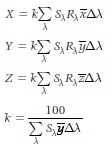appendix D
Tristimulus Value and Chromaticity Coordinate Calculations
To determine the tristimulus values X, Y, and Z for an object, the spectral power distribution of the illuminant, Sλ, the object's spectral reflectance factor, Rλ, and the CIE standard observer color-matching functions, xλ, yλ, and zλ, are integrated together as follows:

The S, R and either, x, y, and z, are multiplied together at each wavelength sampled. The Δλ represents the wavelength interval that measurements are made at. Although the interval can vary, it is usually 10 or 20 nanometers for objects. The £λ indicates that the products of multiplications are summed across wavelengths measured. The k is a normalizing constant.
The CIE color matching functions are provided at 1 nm increments from 360 to 830 nm. The ideal situation would be that the measurements of the object and illuminant be done over the same range using the same interval. Most spectrophotometers are not designed this way, instead they typically will range from 400 to 700 nm in increments of either 10 or 20 nm.
When the tristimulus values have been calculated the chromaticity coordinates can then be determined with the following equations:

It is worth noting that x + y + z = 1.
